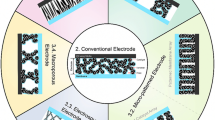Abstract
The effects of electron-beam irradiation on the physicochemical and electrochemical properties of polyethylene (PE) separators are investigated. The high-energy electron-beam irradiation creates carbonyl bands on the surface of bare PE separators, however, it does not affect morphology and pore structure of the separators. In addition, cells employing the electron-beam-irradiated PE separators clearly exhibit better ionic conductivity and rate capability without any degradation in cycling performance compared to cells employing the bare PE separator. This improvement is explained by a formation of new functional group on PE surface—the electron-beam irradiation creates carbonyl group on the surface of the PE separator and it readily facilitates the migration of Li+ and improves solvent affinity of the PE separators. Furthermore, the thermal stability of PE separators is effectively enhanced by irradiating them with electron beams. The thermal shrinkage of the electron-beam-irradiated PE separators is observed to be much lower than that of bare PE separators, resulting in an increased gap between the shut-down and melting integrity temperatures. From these results, it is believed that the electron-beam irradiation can be considered as an effective approach to enhance electrochemical and thermal properties of PE separator.








Similar content being viewed by others
References
Zhang SS, Xu K, Jow TR (2003) Tris(2,2,2-trifluoroethyl) phosphite as a co-solvent for electrolytes in Li-ion batteries. J Power Sources 113:166–172
Arora P, Zhang Z (2004) Battery separators. Chem Rev 104:4419–4462
Venugopal G, Moore J, Howard J, Pendalwar S (1999) Characterization of microporous separators for lithium-ion batteries. J Power Sources 77:34–41
Uchida I, Ishikawa H, Mohamedi M, Umeda M (2003) AC-impedance measurements during thermal runaway process in several lithium/polymer batteries. J Power Sources 119–121:821–825
Wu MS, Chiang PCJ, Lin JC, Jan YS (2004) Correlation between electrochemical characteristics and thermal stability of advanced lithium-ion batteries in abuse tests-short circuit tests. Electrochim Acta 49:1803–1812
Huang X (2011) Separator technologies for lithium-ion batteries. J Solid State Electrochem 15:649–662
Park JH, Cho JH, Park W, Ryoo DJ, Yoon SJ, Kim JH, Jeong YU, Lee SY (2010) Close-packed SiO2/poly(methyl methacrylate) binary nanoparticles-coated polyethylene separators for lithium-ion batteries. J Power Sources 195:8306–8310
Xiang H, Chen J, Li Z, Wang H (2011) An inorganic membrane as a separator for lithium-ion battery. J Power Sources 196:8651–8655
Cho TH, Sakai T, Tanase S, Kimura K, Kondo Y, Tarao T, Tanaka M (2007) Electrochemical performance of polyacrylonitrile nanofiber-based nonwoven separator for lithium-ion battery. Electrochem Solid State Lett 10:A159–A162
Cho TH, Tanaka M, Ohnishi H, Kondo Y, Yosikazu M, Nakamura T, Sakai T (2010) Composite nonwoven separator for lithium-ion battery: development and characterization. J Power Sources 195:4272–4277
Krupa I, Luyt AS (2001) Thermal and mechanical properties of LLDPE cross-linked with gamma radiation. Polym Degrad Stab 71:361–366
Shaban AM, Kinavvy N (1995) Crosslinking rate dependence on thickness of high-density polyethylene sheets after gamma-ray irradiation in the presence of air. Polymer 36:4767–4770
George J, Kumar R, Sajeevkumar VA, Sabapathy SN, Vaijapurkar SG, Kumar D, Kchawahha A, Bawa AS (2007) Effect of gamma-irradiation on commercial polypropylene based mono- and multi-layered retortable food packaging materials. Radiat Phys Chem 76:1205–1212
Croonenborghs B, Smith MA, Strain P (2007) X-ray versus gamma irradiation effects on polymers. Radiat Phys Chem 76:1676–1678
Kim KJ, Kim YH, Song JH, Jo YN, Kim JS, Kim YJ (2010) Effects of gamma ray irradiation on thermal and electrochemical properties of polyethylene separator for Li ion batteries. J Power Sources 195:6075–6080
Fintzou AT, Kontominas MG, Badeka AV, Stahl MR, Riganakos KA (2007) Effect of electron-beam and gamma-irradiation on physicochemical and mechanical properties of polypropylene syringes as a function of irradiation dose: study under vacuum. Radiat Phys Chem 76:1147–1155
Mathakari NL, Bhoraskar VN, Dhole SD (2008) Me V energy beam induced damage in isotactic polypropylene. Nucl Instrum Meth B 266:3075–3080
Murthy MR, Rao EV (2002) Ion-beam modifications of the surface morphology and conductivity in some polymer thin films. Bull Mater Sci 25:403–406
Chytiri S, Goulas AE, Riganakos KA, Kontominas MG (2006) Thermal, mechanical and permeation properties of gamma-irradiated multilayer food packaging films containing a buried layer of recycled lower-density polyethylene. Radiat Phys Chem 75:416–423
Evelyn AL, Ila D, Zimmerman RL, Bhat K, Poker DB, Hensley DK (1998) Effects of MeV ions on PE and PVDC. Nucl Instrum Methods Phys Res B 141:164–168
Popok VN, Azarko II, Odzhaev VB, Toth A, Khaibullin RI (2001) High fluence ion beam modification of polymer surfaces: EPR and XPS studies. Nucl Instrum Methods Phys Res B B178:305–310
Sohn JY, Gwon SJ, Choi JH, Shin J, Nho YC (2008) Preparation of polymer-coated separators using an electron beam irradiation. Nucl Instrum Methods Phys Res B 266:4994–5000
Kim KJ, Kim JH, Park MS, Kwon HK, Kim H, Kim YJ (2012) Enhancement of electrochemical and thermal properties of polyethylene separators coated with polyvinylidene fluoride-hexafluoropropylene co-polymer for Li-ion batteries. J Power Sources 198:298–302
Yasuaki N (2001). Japan Patent 2001-207713
Acknowledgments
This work was supported by the Energy Efficiency and Resources program of the Korea Institute of Energy Technology Evaluation and Planning (Project No. 20112010100140) and R&D program (Project No. 10041942) of the Ministry of Trade, Industry, and Energy, Republic of Korea.
Author information
Authors and Affiliations
Corresponding author
Rights and permissions
About this article
Cite this article
Kim, K.J., Park, MS., Yim, T. et al. Electron-beam-irradiated polyethylene membrane with improved electrochemical and thermal properties for lithium-ion batteries. J Appl Electrochem 44, 345–352 (2014). https://doi.org/10.1007/s10800-014-0661-7
Received:
Accepted:
Published:
Issue Date:
DOI: https://doi.org/10.1007/s10800-014-0661-7




